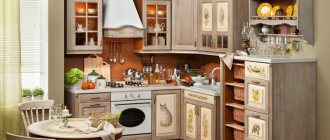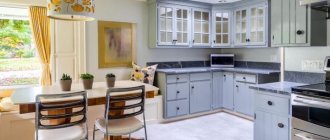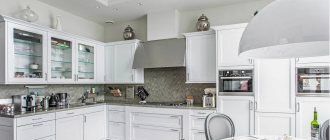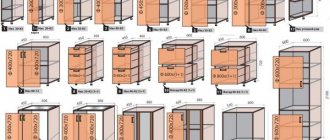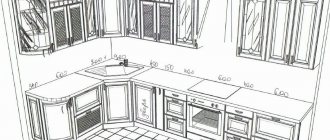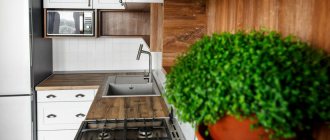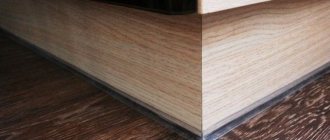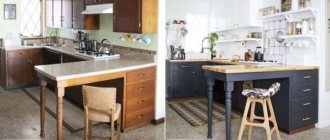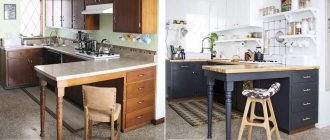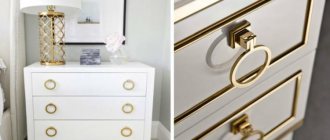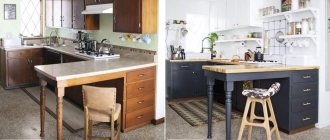Repair is usually a costly and troublesome task, except when it is done on your own. If you approach the matter wisely, you can get a wonderful result while spending a small amount of effort and money.
When initially choosing facades for the kitchen, you need to pay attention not to the appearance, but to how wear-resistant the material used is (reaction to elevated temperatures and humidity, the action of acids and alkalis, fragility of structures, susceptibility to chips and scratches), as well as to repairability later.
Almost all external parts of the kitchen are made of MDF, chipboard or solid wood and form its base, which is covered with a decorative coating on top.
Such a coating can be various films, plastic, veneer or acrylic. It is their properties that will determine how long the kitchen can serve without requiring repairs.
Coating restoration
Restoration of kitchen facades depends on both the base material and the finishing layer. In most cases, if the main material is damaged, the entire façade will have to be replaced. The exception is small scratches and chips, which can be repaired with a special wood putty or wax pencil.
When the finish is damaged, everything is not so clear.
- PVC film. The material does not adhere very well to chipboard or MDF due to its different nature. Over time, as well as under the influence of moisture and temperature changes, the film peels off. The advantage of the material is that restoration of such a coating is quite possible.
For small defects, the PVC film is simply glued: draw PVA glue, “Moment”, into a syringe from a needle and fill the area under the film. Then smooth out the coating and secure with tape for 4 hours. If the damage is extensive, you can remove the entire old film from the facade by heating it with a hairdryer, and stick a new one in the same way. In this case, it is better to use liquid nails.
- Melamine and acrylic films have much better adhesion to wood material, so they rarely peel off. Small areas are glued in the same way, but if the damage is extensive, the façade cannot be repaired at home: the coating will have to be changed in a workshop.
- Acrylic panel. This type of kitchen renovation is impossible. In case of severe chips or scratches, the sash must be replaced with a new one.
- The veneer is glued as easily as PVC film. Replacing it is also not difficult: the material is produced with glue already applied to the back side.
- Enamel. Repairing kitchen facades with your own hands is quite possible, although the work requires extreme care. Firstly, you need to clean out scratches or peelings, secondly, choose exactly the same shade, thirdly, apply it very carefully. If there is a large area of damage, it is better to entrust the work to a professional.
Upgrade with PVC film
Restoration does not always mean only returning facades to their original appearance and replacing fittings. Modern methods of decoration make it possible to change the appearance of a kitchen beyond recognition, using quite affordable means.
One of these options is vinyl film, or rather, a sticker with an image on PVC film. Moreover, the image can be anything - from a wood pattern to an ornament of any complexity or a landscape.
Quite often, this technique is used to change the style of the kitchen or simply diversify the design. To do this, decorate an area or two doors with a sticker. If they want to update their entire set, all facades are covered with vinyl film. The choice is entirely determined by the style of the room.
Paneled facades are very suitable for such kitchen renovations. The frames are painted or also covered with a film of a different color, and the inner surface is decorated with self-adhesive film.
The photo shows a successful solution in the Art Nouveau style.
How to fix the problem?
If the film on the facade of the MDF kitchen has peeled off , you need to carefully spread it with glue from the edge and press it down. There is a chance that the film will take the desired shape. Another way to restore the coating is to use an adhesive membrane. To do this, you will need to lay the boards on a dry and flat surface, for example, on a table, cover them with a membrane, and use a vacuum. The membrane should tightly cover the facades. If you want greater reliability, you need to use high-quality glue and heat the material so that it can be activated. Warming up should be done evenly. This method is suitable only for unmilled facades: if the surface is uneven, the membrane will not stick and will quickly peel off. Therefore, it is so important to carry it out correctly, observing certain conditions.
Coloring
Restoring kitchen facades using painting is the second most popular method. It is worth noting that it is far from being as simple as it seems at first glance. All facades are painted with the exception of MDF doors with acrylic panels.
Polyurethane enamels are preferable among kitchen materials. They are resistant to moisture and temperature changes, are not afraid of light, dry quickly and are safe. In addition, the palette of paints includes all kinds of shades and textures - from matte to high-gloss, literally with a mirror shine.
How to restore a kitchen set by painting?
- Remove all the fittings from the sashes, then remove the facades themselves.
- The finishing layer is completely removed and the surface is cleaned with sandpaper.
- The material is primed - it is recommended to use a water-based polyurethane primer. The procedure should be repeated and wait for the primer to dry completely.
- Apply paint using a roller and brushes of different sizes. The paint must be applied in several layers, first allowing each layer to dry completely. The carved parts of the product are especially carefully painted. Using a stencil, you can create a pattern, ornament or image on the sash.
- When restoring the facade, do not forget about the final stage - varnishing. No matter how good the enamel is, varnish will prevent its mechanical damage.
Coloring techniques are different. Depending on your own skill, you can simply paint the facade with one color, you can paint it, you can paint the kitchen set with “metallic” paint - it contains aluminum powder.
The fashionable aging effect is obtained in this way: the facade is covered in two layers with paint of different shades, and after drying, a solvent is applied to the surface. In this case, the top layer becomes covered with cracks. With the right skill, you can also achieve a “chameleon” effect: this will also require painting in two colors, but after drying, the facades are coated with glossy varnish.
What to do if the film on the MDF facade peels off?
The kitchen is the home of the housewife, where she can prepare food and spend time having a pleasant conversation with relatives or friends. In this same room, guests are often welcomed and home holidays are celebrated. Therefore, kitchen renovation is a very important undertaking. It is especially important to choose the right kitchen set, consisting of several pieces of furniture.
Modern owners very often choose furniture that is covered with MDF film. We can safely say: film is the future, because painted facades are not so practical, elegant, and are more difficult to restore. MDF film:
- Looks neat;
- Lasts longer than paint;
- It is cheaper to produce;
- Always looks smart;
- It is very easy to restore.
In addition, the enamel can swell and peel off, and the film can be re-glued using a minimum resource, and you can even do it yourself.
Industrial cladding
Even in production for industrial cladding, a film is glued onto specially prepared boards (wood-based materials) using the vacuum pressing method. Hot film using special hot melt adhesive is applied to the façade elements. After the MDF hardens, the excess material is simply cut off from the ends.
If a defect appears on the facade
It happens that MDF film may peel off during long-term use. Here you will have to carry out your own restoration. In order to complete the work, you need to prepare PVC film, degreaser or white spirit, a soft cloth, a plaster spatula (wide and always new), you will need a sharp utility knife, scissors and a household hair dryer.
The work will include several main stages that will have to be performed sequentially.
- To begin with, the surface will have to be thoroughly prepared by cleaning the seams with white spirit, ridding the facade of all kinds of greasy stains and dirt.
- Then you need to cut the film to size, attach the edge of the self-adhesive film to the facade and gradually separate the edge of the backing.
- The roll must be unrolled very carefully so that there are not too many bubbles and defects.
- To level, you need to use a wide spatula, with which you can remove bubbles that will spoil the appearance.
Decoupage
To restore the facades of kitchen furniture, sometimes they resort to not entirely traditional methods. Decoupage has become a trendy touch for retro kitchens. But in practice it is used quite rarely, as it requires taste and accuracy in execution.
The material for decoupage is special napkins with bright original images. In fact, in this capacity you can use newspaper clippings, pieces of fabric, fragments of lace, your own old photos, a finished image from albums or books. In the kitchen, decoupage using small objects will be very useful: coffee beans, herb stems and spikelets, dried flowers and the like.
The decoupage technique is quite simple: you sand the kitchen set with your own hands using coarse and then fine sandpaper. They are painted with a background color - acrylic paint is used, and then the image or objects are fixed to the surface using office glue. Be sure to cover the craft with several layers of transparent furniture varnish after the glue has dried.
The photo shows “plant-based” kitchen decoupage.
Method 1: Painting the kitchen with chalk paint
Do you want to update your kitchen set beyond recognition with your own hands? The best way to do this is to repaint the facades with chalk (mineral) paint. Why chalk?
- The fact is that this type of paint has a thicker consistency and increased adhesive properties, due to which it fits perfectly on any surface - even on laminated chipboard/MDF. Moreover, chalk paints eliminate the need for tedious sanding and sometimes even without primer.
Chalk paints are also good because they give the painted surface a texture similar to that obtained when painting a wooden surface. Therefore, even the most ordinary kitchen with film facades will look much more noble after such an “update”.
- In Russia and the CIS countries, you can buy chalk paints from designer Daria Geiler, foreign manufacturer Annie Sloan, Kazakh Vernenskaya Manufactory, etc. You can also make chalk paints yourself using recipes that are easy to find on the Internet.
Varnishing
Repairing a kitchen set made of wood comes down to restoration, especially if the material is quite expensive wood. And old wooden furniture, both today and centuries ago, is perceived as a symbol of solidity. Moreover, wooden kitchen units are not that difficult to update.
The most popular techniques are varnishing and tinting; they are often combined. The varnish can be used as matte transparent, glossy or even colored. It doesn’t radically change the color palette of the furniture, but it does add some shade. Stain is used in cases where they really want to change the color of the facade by a couple of tones.
The technology of both processes is similar.
- The facades are removed from their hinges and the fittings are removed.
- The surface is cleaned of old varnish or other finishing, treated with sandpaper, coarse and fine, and then thoroughly sanded.
- The cleaned surface is primed.
- After the primer has completely dried, a layer of varnish is applied to the facade with a brush. After the varnish has dried, the procedure is repeated at least twice.
The stain is applied in the same way, after the soil has dried. Depending on how much they want to change the color of the furniture, tinting is carried out from 1 to 4 times. Then the product is opened with varnish at least twice.
Molding – furniture plinth of different shapes – will help diversify the look of updated furniture. It is very diverse in size and configuration. The molding is glued to the surface of the facade and can be painted and varnished along with the sash.
Unusual solutions
The imagination of home craftsmen literally has no limits, so completely unexpected things can serve as materials for kitchen renovation.
- Photo wallpaper is a material that is in no way inferior to PVC film in terms of density and strength. It is fixed to the surface of chipboard, MDF and even plastic with liquid nails. Photo wallpapers are cut to the size of the facades and pasted in the most usual way. After the glue has dried, the products must be opened with varnish. If desired, you can order photo wallpapers with images from your personal archive.
- Tile finishing. As a rule, walls are decorated with ceramics. However, nothing prevents you from using this beautiful material as decoration for a flat or paneled facade. The tiles are cut and fixed using the same liquid nails.
- An even more interesting, but also labor-intensive option is porcelain mosaic. There are not enough broken dishes from one apartment for this, so you will have to get the fragments somewhere: if you negotiate with the nearest cafes and restaurants, you will get the material quite quickly. The fragments are sorted by color, used to form a pattern or simply a color gradient and glued to the surface of the facade. The gaps between the fragments are sealed with grout.
Restoring kitchen furniture should first of all restore functionality. However, the process is creative and exciting, so that as a result the kitchen can completely change its appearance.
- VKontakte
